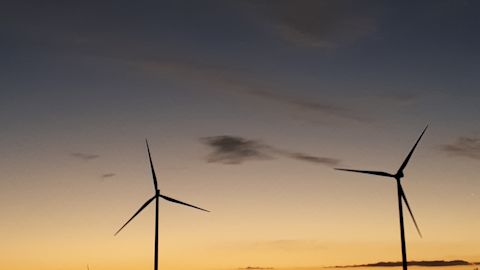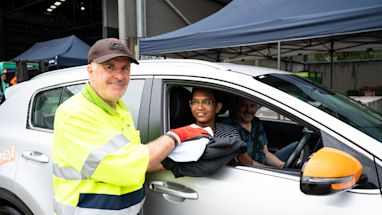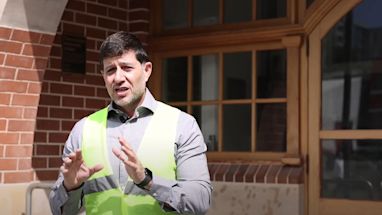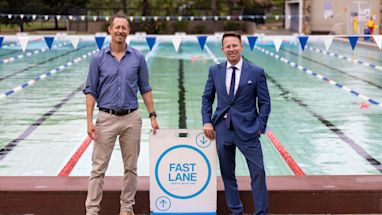As Australia gets to grips with the economic shock caused by the coronavirus pandemic, many commentators are calling for the recovery to be powered by renewables, not fossil fuels.
For businesses and local governments, one way to achieve this is to take up an innovative green electricity deal known as a power purchase agreement (PPA).
The City of Sydney has done just that: from 1 July 2020, we’re using this agreement to purchase renewable electricity from wind and solar farms in regional NSW to cover all our operations. This includes approximately 115 buildings – including libraries, community halls, and office buildings – 75 parks, 5 pools and 23,000 street lights. It’s one of the largest standalone renewable electricity agreements for an Australian council to date.
How exactly does our deal work? And why should you care? Read on to discover the ins and outs of PPAs and learn about how we’re helping to grow renewable electricity in regional NSW.
1. We’re buying this electricity from 3 generators
We’ve struck a deal with an electricity retailer to source renewable electricity from 3 different generators, all based in regional NSW. The electricity retailer, Flow Power, has agreed to purchase an amount of electricity equivalent to 100% of the City's usage, then add it to the national electricity grid on our behalf. About three-quarters of the power will be wind-generated, and the remaining quarter will be generated by solar.
The generators we settled on are Sapphire Wind Farm, Bomen Solar Farm and Repower Shoalhaven (solar). Each farm is at a different stage of development, meaning the agreement will launch in stages from 1 July before coming into full effect in 2021. The deal lasts for 10 years, giving us price certainty in a volatile electricity market.
Embedded content: https://youtube.com/shorts/9p9Nj42J8Bw
We gave Flow Power criteria that all 3 renewable generators needed to meet to be part of our agreement.
These included being:
- located in NSW to reduce the marginal loss factor and help provide more jobs in the regional economy
- able to achieve a combined 80% load matching – see ‘Why our electricity comes from multiple generators’ below
- able to provide a price-capped product
- including a demand response option – see ‘How this electricity deal prepares us for the future’ below.
We also wanted at least one of the participating generators to be community-operated.
Some organisations setting up power purchase agreements choose to deal directly with renewable electricity generators rather than go through a broker or retailer. But we chose to work with Flow Power because it’s an expert in the field and will look after many of the technical (and riskier) details on our behalf.
2. How we can be sure this renewable electricity goes to the grid
Across Australia, renewable energy generators such as solar and wind farms receive certificates from the federal government when they produce a certain amount of certified renewable electricity. These nifty documents are known as large-scale generation certificates and each recognises the production of 1 MWh of electricity.
When an electricity generator sells its renewable electricity, it also passes along its certificate to the buyer (think of it as a receipt for renewable energy). In our case, Flow Power receives the certificates and then passes them along to us as proof we’re buying 100% renewable electricity.
When individuals and businesses sign up for GreenPower, they receive these certificates too.
3. We're using this deal to support new renewable electricity projects
When we decided to pursue a 100% renewable electricity deal, we knew we wanted to help grow the renewables sector in NSW as well. We didn’t want to simply buy renewable electricity that was already being produced. So we worked with our broker to make sure we were supporting new projects.
We ended up partnering with a community energy group that needed help to get a project off the ground. Repower Shoalhaven could not have become operational without our investment.
By partnering with this project, we’re stimulating the market and helping the renewables sector grow.

4. Why our electricity comes from multiple generators
It might seem less efficient for us to be sourcing our electricity from 3 different parts of NSW, but in fact it’s the best way to use less ratepayers’ money on electricity.
That’s because prices in the electricity market are constantly fluctuating – sometimes every 5 minutes – based on supply and demand, similar to the stock market.
By signing up with 3 different generators, we’re able to purchase electricity from whichever generator has cheaper electricity at the time we need it, saving us money. Even though we’re not physically getting renewable electricity from the generators, the electricity market works like we are.
The process of buying electricity from a generator when its output matches your demand is known as load matching. For example, if you use most of your electricity at night, like we do, you choose to buy more wind power than solar power. It’s not just a good idea financially – if every large electricity buyer practised load matching, our electricity grid would become much more stable and sustainable.
Embedded content: https://youtu.be/hTtINv64cA8
5. How this electricity deal prepares us for the future
Our renewable electricity deal started 1 July 2020 but we’re already looking to the future and how our electricity use might evolve in the years ahead. As more Australian individuals and organisations generate power themselves using rooftop solar, the opportunities will increase for a 2-way system that involves electricity users both buying and selling electricity. Many households in the City of Sydney area already sell their excess solar power back to the grid.
There’s also the practice known as demand response. This is when consumers choose not to use electricity during times of high demand in exchange for lower rates or some other form of reward.
The NSW electricity market is moving towards a demand response model and we’re going to be at the forefront of it. That’s why we’ve included provisions for demand response in our current power purchase agreement.
The city’s lights will stay on when there’s no sun or wind
We’re still connected to the national electricity grid, like most people. The grid receives and distributes electricity from all the generators (coal, hydro, wind and solar) in the country.
Under the terms of our agreement, we pay the wind and solar farms for renewable energy certificates that are produced by feeding the same amount of renewable electricity into the grid as used by the City each year.
Still curious?
Want to know more about the nitty gritty of power purchase agreements? Check out this comprehensive guide (PDF).
How you can use renewable electricity at home if installing solar isn't an option
The best thing you can do is to switch to an official 100% GreenPower electricity plan. Most providers sell it, but they might call it different names, like green energy.
Sydneysiders are telling us there are some very good GreenPower rates available. You can shop around and negotiate a good deal. It's not always easy to find everything you need to know on websites. We recommend calling electricity providers and asking them to switch you to their 100% GreenPower offer for what you're paying now or less.
Published 1 July 2020, updated 14 December 2023



